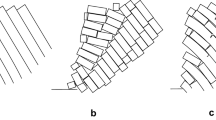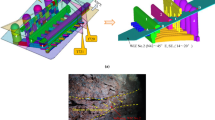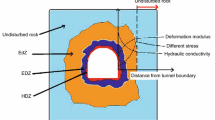Abstract
A weak interlayer zone (WIZ) is a poor rock mass system with loose structure, weak mechanical properties, variable thickness, random distribution, strong extension, and high risk due to the shear motion of rock masses under the action of tectonism, bringing many stability problems and geological hazards, especially representing a potential threat to the overall stability of rock masses with WIZs in large underground cavern excavations. Focusing on the deformation and failure problems encountered in the process of excavation unloading, this research proposes comprehensive in situ observation schemes for rock masses with WIZs in large underground cavern on the basis of the collection of geological, construction, monitoring, and testing data. The schemes have been fully applied in two valuable project cases of an underground cavern group under construction in the southwest of China, including the plastic squeezing-out tensile failure and the structural stress-induced collapse of rock masses with WIZs. In this way, the development of rock mass failure, affected by the step-by-step excavations along the cavern’s axis and the subsequent excavation downward, could be observed thoroughly. Furthermore, this paper reveals the preliminary analyses of failure mechanism of rock masses with WIZs from several aspects, including rock mass structure, strength, high stress, ground water effects, and microfracture mechanisms. Finally, the failure particularities of rock masses with WIZs and rethink on prevention and control of failures are discussed. The research results could provide important guiding reference value for stability analysis, as well as for rethinking the excavation and support optimization of rock masses with WIZs in similar large underground cavern under high geostress.






























Similar content being viewed by others
References
Barla G, Forlati F, Bertacchi P, Zaninetti A (1987) Shear behaviour of natural filled joints. In: Proceedings of the 6th congress of the international society for rock mechanics, pp 291–300
Bieniawski ZT (1973) Engineering classification of jointed rock masses. Trans S Afr Inst Civil Eng 15(12):335–344
Bieniawski ZT (1989) Engineering rock mass classifications. Wiley, New York
Bruneau G, Hudyma MR, Hadjigeorgiou J, Potvin Y (2003) Influence of faulting on a mine shaft—a case study: part II—numerical modelling. Int J Rock Mech Min Sci 40(1):113–125
Chu CJ (1997) Shear displacement of rock strata and its effect on the stability of foundation slope. Chin J Rock Mech Eng 16(4):312–319 (in Chinese)
De Toledo PEC, De Freitas MH (1993) Laboratory testing and parameters controlling the shear strength of filled rock joints. Geotechnique 43(1):1–19
Ding XL, Dong ZH, Lu B, Zhang F, Wu AQ (2008) Deformation characteristics and feedback analysis of surrounding rock of large underground powerhouses excavated in steeply dipped sedimentary rock strata. Chin J Rock Mech Eng 27(10):2019–2026 (in Chinese)
Duan SQ, Feng XT, Jiang Q, Xu DP, Xu H, Liu GF (2016) Experimental study of mechanical properties of staggered zones under loading and unloading conditions of high stresses. Chin J Rock Mech Eng 35(6):1090–1101 (in Chinese)
Feng Y (1998) The engineering geological conditions of Xiangjiaba hydropower station. Water Power 24(2):9–12 (in Chinese)
Feng XT, Wang YJ (1995) Artificial neural network of the residual strength of mudded intercalation. Trans Nonferr Met Soc China 5(3):17–21 (in Chinese)
Feng XT, Hao XJ, Jiang Q, Li SJ (2016) Rock cracking indices for improved tunnel support design: a case study for columnar jointed rock masses. Rock Mech Rock Eng 6:1–16
Guo Z (1982) The mechanical effect of the thickness of the weak intercalated layers within undulated weak structural plane. Hydrogeol Eng Geol 9(1):33–39 (in Chinese)
Hansmire WH (1978) Suggested methods for monitoring rock movements using borehole extensometers. Int J Rock Mech Min Sci 15(6):305–317
Hendron AJ, Patton FD (1987) The Vaiont slide—a geotechnical analysis based on new geologic observations of the failure surface. Eng Geol 24(1):475–491
Hoek E, Kaiser PK, Bawden WF (1995) Support of underground excavations in hard rock. A. A. Balkema, Rotterdam
Hu RL, Li XQ (1999) Engineering geology new branch in the 21st century: soil micromechanics. Hydrogeol Eng Geol 26(4):5–8 (in Chinese)
Indraratna B, Haque A, Aziz N (1999) Shear behaviour of idealized filled joints under constant normal stiffness. Geotechnique 49(3):331–355
Indraratna B, Jayanathan M, Brown ET (2008) Shear strength model for over consolidated clay-filled idealised rock joints. Geotechnique 58(1):55–65
Indraratna B, Oliveira DAF, Brown ET (2010) A shear-displacement criterion for soil-filled rock discontinuities. Geotechnique 60(8):623–633
Jia ZY (1994) Engineering geological expert system for interlayer shear zone. Hydrogeol Eng Geol 21(3):29–34 (in Chinese)
Jiang Q, Feng XT, Zhou H, Zhao Y, Xu DP, Huang K, Jiang YL (2011) Discussion of strength value for interlayer shear belt. Rock Soil Mech 32(11):3379–3386 (in Chinese)
Ladanyi B, Archambault G (1977). Shear strength and deformability of filled indented joints. In: Proceedings of the 1st international symposium on geotechnics of structurally complex formations, pp 317–326
Lama RD (1978) Influence of clay fillings on shear behaviour of joints. In: Proceedings of the 3rd congress on international association of engineers and geologists, vol 2, pp 27–34
Lan TY, Tang YQ (2008) Rock mass displacement analysis on the left bank of Xiluodu hydropower station underground powerhouse. China Three Gorges Constr 1:73–78 (in Chinese)
Li SJ, Feng XT, Wang CY, Hudson JA (2013) IRSM suggested method for rock fractures observations using a borehole digital optical televiewer. Rock Mech Rock Eng 46(3):635–644
Martin CD (1990) Characterizing in situ stress domains at the AECL underground research. Can Geotech J 27(27):631–646
Martin CD, Chandler NA (1993) Stress heterogeneity and geological structures. Int J Rock Mech Min Sci Geomech Abstr 30(7):993–999
Papaliangas T, Hencher SR, Lumsden AC, Manolopoulou S (1993) The effect of frictional fill thickness on the shear strength of rock discontinuities. Int J Rock Mech Min Sci Geomech Abstr 30(2):81–91
Phien-wej N, Shrestha UB, Rantucci G (1990) Effect of infill thickness on shear behaviour of rock joints. In: Barton Stephansson (ed) Rock joints: proceedings of the international conference on rock joints. Balkema, Rotterdam, pp 289–294
Shen B, King A, Guo H (2008) Displacement, stress and seismicity in roadway roofs during mining-induced failure. Int J Rock Mech Min Sci 45(5):672–688
Sun WH, Zhen TM, Li MY (1981) The mechanical effect of the thickness of the weak intercalary layers. In: Proceedings of international symposium on weak rock, Tokyo, Japan, pp 49–54
Sun HY, Wong LNY, Shang YQ, Lu Q, Zhan W (2010) Systematic monitoring of the performance of anchor systems in fractured rock masses. Int J Rock Mech Min Sci 47(6):1038–1045
Takahashi T, Takeuchi T, Sassa K (2006) ISRM suggested methods for borehole geophysics in rock engineering. Int J Rock Mech Min Sci 43(3):337–368
The Ministry of Water Resources of China (1994) China national standards GB50218-94: standard for engineering classification of rock masses. China Planning Press, Beijing (in Chinese)
Wang SJ (1990) Analysis of rock mass engineering geological mechanics. Science Press, Beijing (in Chinese)
Wang SM (1996) Construction of knowledge model of expert system for interlayer shear zone. J Eng Geol 4(2):44–50 (in Chinese)
Wang XF, Liu W, Er L (1983) Structure type and microstructure of clay intercalation. J Jilin Univ (Earth Sci Ed) 13(4):73–84 (in Chinese)
Wang CY, Ge XR, Bai SW (2002) Study of the digital panoramic borehole camera system. Chin J Rock Mech Eng 21(3):398–403 (in Chinese)
Wang MH, Feng WK, Liu HC, Bai SW (2003) Rock mass structure characteristics and classification in Xiluodu underground powerhouse. J Mt Sci 21(1):101–105 (in Chinese)
Xiao SF, Argelov K (1991) Structures of interlayer shear zones and their creeping behaviour. Jilin Science Press, Changchun (in Chinese)
Xu DP (2011) Study on the shear strength of interlayer shear weakness zone and its effect on the overall stability of cavern group, Ph.D. thesis. Institute of Rock and Soil Mechanics, Chinese Academy of Sciences (in Chinese)
Xu DP, Feng XT, Cui YJ, Jiang Q, Zhou H (2012) On failure mode and shear behaviour of rock mass with interlayer staggered zone. Rock Soil Mech 33(1):129–136 (in Chinese)
Xu DP, Feng XT, Cui YJ (2013) An experimental study on the shear strength behaviour of an interlayered shear weakness zone. Bull Eng Geol Environ 72(3–4):327–338
Zhao RH, Sun GZ (1978) Principle and method of stability analysis of soft interlayer, Institute of Geology, Chinese Academy of Sciences. Geological mechanics of rock mass engineering. Science Press, Beijing (in Chinese)
Acknowledgements
The authors acknowledge the financial support provided by the National Natural Science Foundation of China under Grant Nos. 11232024 and 41320104005. Authors like to thank the staff of the China Three Gorges Project Corporation, East China Investigation and Design Institute, China Gezhouba Group Corporation, and Sinohydro Bureau 7 Co., Ltd, for their technical support. Authors also wish to thank Prof. Y.J. Cui, Prof. S.J. Li, Dr. D.P. Xu, and Mr. Z.B. Yao for their kind help.
Author information
Authors and Affiliations
Corresponding author
Rights and permissions
About this article
Cite this article
Duan, SQ., Feng, XT., Jiang, Q. et al. In Situ Observation of Failure Mechanisms Controlled by Rock Masses with Weak Interlayer Zones in Large Underground Cavern Excavations Under High Geostress. Rock Mech Rock Eng 50, 2465–2493 (2017). https://doi.org/10.1007/s00603-017-1249-4
Received:
Accepted:
Published:
Issue Date:
DOI: https://doi.org/10.1007/s00603-017-1249-4




